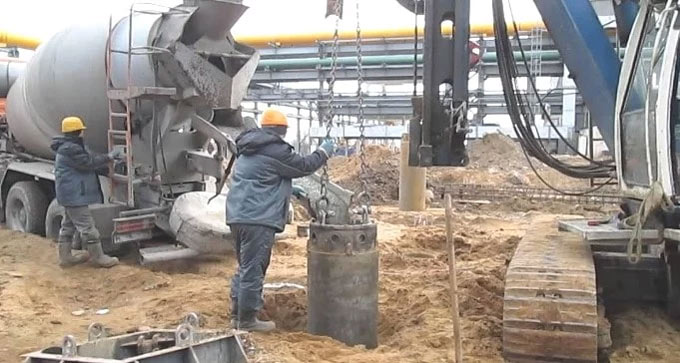
Details of Cast in Situ Concrete Piles and their advantages
Cast In Situ belongs to a construction item or structural member similar to a beam or in this case a Pile that should be built up, assembled or poured at site instead of prefabrication in a factory. Normally, in cast in place or cast in situ construction, concrete is delivered from a batch plant to site where it is poured and compressed into the formwork that is fixed in required shape and dimensions at site.
Cast in situ or cast-in-place piles are cast in position inside the ground; generally in such type of piles, drilling of necessary diameter and depth into the ground is done with an auger drilling device or a drill bit.
There is a helical screw blade generally known as a ?fighting blade? inside the device that functions as a screw conveyor to eliminate the drilled out material. Besides, auger drilling an old method known as percussion drilling is also applied for excavating the hole. Under this method, a heavy cutting or hammering bit affixed to a roper or cable is lowered in the open hole or inside a temporary casing.
After entering deep into the ground, a temporary steel casing is lowered in the borehole to safeguard loose soil from dropping in the borehole.
The verticality of the casing should be examined precisely prior to start. Once the optimal depth is attained, the reinforcement cage with vertical rebars and stiffeners is lowered within the borehole, and the upper part is hanged at the top. The concreting is generally performed with Tremie method of concrete piling.
There are normally 6 types of cast in situ piles as below:-
1. Simplex Pile, 2. Franki Pile, 3. Vibro Pile, 4. Vibro Expanded Pile, 5. Raymond Pile, 6. Mac Arthur Pedestal Pipe
Benefits of Cast In Situ Concrete Piles: The cast in situ piles are set up with pre-excavation and reduce the vibration because of driving as in case of driven piles.
In housing area, sound pollution may occur if the piles are entered by hammering. To get rid of this issue, situ piling is suitable in such areas.
For water logged area, cast in situ piling with permanent casing is very effective.
The skin friction resistance with the ground is fully used in cast in situ piles throughout the design phases that is not recommended in case of driven piles where only the end bearing is applied.
Normally, there is no need of any foreign materials and tools and the original equipments and materials will meet the requirements of a project, as a result the cast-in-situ piles become as a cost-effective and adjustable type of pile foundation.
Precast piles should be designed to satisfy the handling and driving stresses thus enhancing the essential reinforcement that does not happen in the case of cast in situ piles and therefore, the amount of necessary reinforcement is minimized.
Cast in situ piles are attached over the ground with a pile cap that applies a monolithic approach. The top ground is excavated up to pile cut off level from where the slushy low quality concrete is eliminated with hand hilty to retain developed rebars into the pile cap.
Because of this monolithic connection, cast in situ pile provides good resistance against the earthquake and wind forces.
As soon as the piles are casted, no maintenance is required.
Since the materials and machinery applied are obtained from the local community, local contractors can perform the job and not any skilled labor is required for cast in situ piles.
No serious consideration should be provided for joints in cast in situ piles with regards to precast driven piles.


